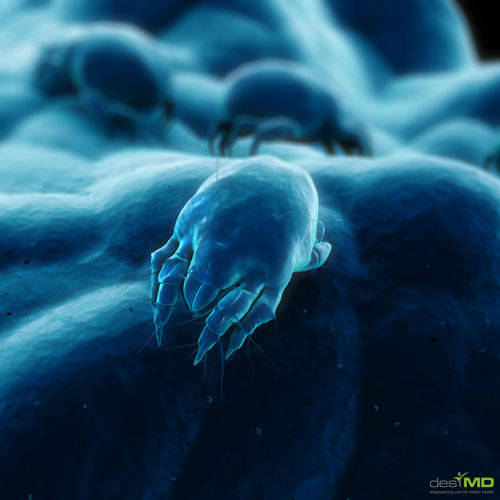Dust Mite Allergy
A hypersensitive reaction to immune system against any particular substance (allergen) is called as allergy. Dust mite allergy refers to hypersensitive reaction caused by exposure to tiny bugs (too small to see with naked eyes) in the dust in our house and premises. These dust mites survive in warm and humid conditions (as in bedding items and furniture in the home) and eat dead skin cells of humans and animals.
Usually, individual mite has ability to produce more than 20 of waste droppings (specific protein) every day that spreads in the environments and settles down with the dust while their ability to cause allergic symptoms remain constant even after they die. The ideal environment for dust mites is when there is a temperature about ≥ 70 F and humidity ranging between 75 to 80 percent.
Along with the live mites, dust also contains faeces, excretions and decayed bodies of dust mites. A specific protein in the mites is responsible for allergic reaction causing nasal inflammation, which triggers further symptoms.
The immune system produces specific antibodies as a defense against foreign substances (allergens) to protect the body from harmful allergens. In case of allergic reactions, as usual, the body produces antibodies against allergens (even if they are not harmful) and leads to an inflammatory response.
Most allergies have some common signs and symptoms. Allergy to dust mites harms nasal passage making it inflamed, causing several clinical manifestations. Common symptoms of dust mite allergy may include:
- Rhinorrhea (persistent discharge of mucus from nose)
- Sneezing
- Itching sensation in the eyes, nose and throat
- Reddening of eyes
- Swelling around the eyes
- Accumulation of excess mucus in the throat (postnasal drip)
- Cough and congestion
- Facial pain and pressure
- Rubbing nose (especially in children)
In chronic cases, one may experience a severe asthma attack that causes:
- Shortness of breath
- Chest pain
- Tightness in the chest
- Abnormal sound while breathing
- Severe coughing and wheezing
- Lack of sleep
Diagnosis of dust mite allergy may begin with discussing with your doctor about the typical symptoms, severity, onset of symptoms and its duration, pets at home, etc. This will help the doctor to further advice other tests, such as allergy tests (to identify the specific allergen) and some blood examinations, examining the body for allergy and assessment of family history..
Immunotherapy (allergy shots or allergy drops under the tongue/ Sublingual immunotherapy (SLIT): When other treatment approaches fail to deliver the results, immunotherapy may be considered. It involves a series of allergen shots with gradually increasing doses (about two shots a week for about 3 months) and then a single shot for every four weeks, for about five years. This helps to build up immunity against specific allergens.
Benefits of SLIT:
- Effective in children in terms of treating the symptoms of rhinitis, asthma, and further worsening of symptoms.
- Effective in preventing future asthma
- Safe and easy to administer
- Can be administered at home
- No need of syringes and needle



+1.svg)
